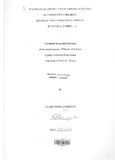| dc.description.abstract | This study examined the difference in nutritional status of children living in Chainda and
Kamanga compounds, both of which are high density peri-urban settlements in Lusaka, Zambia.
The focus ofthe study was on how water availability, diarrhoeal disease and parasitic infection
influence the nutritional status of children under five years of age.
Residents of Chainda compound which was designated the poor water availability (PWA) area
experience chronic water shortages. There is one borehole in the compound that supplies four
public water standpipes. One standpipe serves an average of325 households. Water is however
available from these points at certain times of the day. Often the borehole breaks down leaving
residents without water for days at a time.
Kamanga compound was designated the improved water availability (IWA) area. Irish Aid, an
international NGO, has completely revamped the water supply system in this compound. There
are 6 boreholes and these supply 14 public water standpipes. Each standpipe serves an average
of 125 households. Residents of the IWA area are able to draw unlimited quantities of water
throughout the day. On average, a resident of the PW A area takes 70 minutes to draw one 20
litre water load, as compared to 20 minutes for his/her counterpart living in the IWA area.
Households in the two compound were randomly sampled (124 in PWA and 120 in IWA areas
respectively). The study findings indicate that the amount of water drawn for daily use by
households in the PWA area (101.45 litreS) was not significantly different from that collected by
households in the IWA area (98.92 litres).
One week diarrhoea prevalence was not significantly different in the two study areas. Over half
of the index children had diarrhoea in the one week prior to the survey (50.8% and 53.3% in the
PWA and IWA area respectively). The prevalence levels peaked in the 24-35 month age group
and then declined by over 50% in the older age categories. Parasitic infection rates were
significantly lower in the IWA area as compared to the PWA area (11.7% and 21.8%
respectively). This was likely because in the IWA area children were dewormed more regularly
than their counterparts in the PWA area.
The daily dietary and caloric protein intake of index children (which were 1774 kcal and 39.7
gms protein in the PW A area and 1681 kcal and 34.5 gms protein in the IWA area) were higher
than the levels recommended by FAO for children in this age group. The major nutritional
problems of the study children were stunting and underweight and though not significantly
different, the malnutrition rates were higher in the IWA area than in the PWA area (44.2% and
35% of children in the IWA area and 42% and 28.2% of children in the PWA area were stunted
and underweight respectively). | en |

